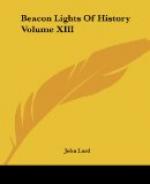It was not until 1842 that the poet again appeared in print, this time with a volume to which he appended his name, “Poems by Alfred Tennyson,” and which gave him high rank among the acknowledged singers of his day,—Wordsworth, Southey, Landor, Campbell, Rogers, and Leigh Hunt, in England; and in the New World, Longfellow, Bryant, Lowell, Whittier, and Emerson. The poet-contemporaries of his youth—Byron, Scott, Coleridge, Shelley, and Keats—had by this time all died, and in 1843 Southey died, when Wordsworth, whom Tennyson reverenced, became Poet Laureate. The gap occasioned by the death of these early English poets of the century was now to be filled in large measure by Tennyson, though among the writers of song to arise were the Brownings, Rossetti, Matthew Arnold, and Swinburne. Critical appreciation of the volume of 1842 was happily encouraging to the poet; indeed, it was most gratifying, for its many remarkable beauties were now justly and adequately appraised, particularly such fine new themes as the volume contained—’Ulysses,’ ‘Godiva,’ ‘The Two Voices,’ ‘The Talking Oak,’ ‘Oenone,’ ’Locksley Hall,’ ‘The Vision of Sin,’ and ‘Morte D’Arthur,’ the germ of the future “Idylls of the King.” Nor on this side the Atlantic did the new volume lack substantial recognition, and from such competent critics as Emerson and Hawthorne; while among his English contemporaries Tennyson became, if we except for the time Wordsworth, the acknowledged head of English song. At this period the poet resided in London or its neighborhood, his family home in Lincolnshire having been broken up in 1837, six years after the death of his father. Here, in spite of the secluded life he led, he became a notable figure in literary circles, and greatly increased the range of his friends, correspondents, and admirers. Among the latter were the Carlyles, Thomas and his clever wife Jane being especially drawn to the poet, and to them we owe interesting sketches of the personal appearance of Tennyson at this time. Mrs. Carlyle, in one of her delightful letters gossiping about Dickens, Bulwer-Lytton, and Tennyson, esteems the latter “the greatest genius of the three,” adding that “besides, he is a very handsome man, and a noble-hearted one, with something of the gypsy in his appearance, which for me is perfectly charming.” This is the historian, her husband’s, piece of portraiture: “A fine, large-featured, dim-eyed, bronze-colored, shaggy-headed man, dusty, smoky, free-and-easy; who swims, outwardly and inwardly, with great composure in an articulate element as of tranquil chaos and tobacco smoke; great now and then when he does emerge; a most restful, brotherly, solid-hearted man.” Another portrait we have from the Chelsea philosopher and scorner of shams which describes the poet very humanly as “one of the finest-looking men in the world, with a great shock of rough, dusky, dark hair; bright, laughing, hazel eyes; massive, aquiline face, most massive, yet most delicate; of sallow-brown




